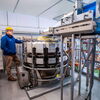
With new agreement, Fluid Imaging expands in medical diagnostics
 Courtesy / Fluid Imaging Technologies
The combination of Fluid Imaging Technologies’ FlowCam Nano with the University of Colorado’s software is expected to cut the time required for physicians to identify bacterial infection. Seen here is the university’s lead researcher, Dr. Theodore Randolph, with the FlowCam Nano imaging system.
Courtesy / Fluid Imaging Technologies
The combination of Fluid Imaging Technologies’ FlowCam Nano with the University of Colorado’s software is expected to cut the time required for physicians to identify bacterial infection. Seen here is the university’s lead researcher, Dr. Theodore Randolph, with the FlowCam Nano imaging system.
Fluid Imaging Technologies Inc. has signed an exclusive licensing agreement with the University of Colorado to commercialize artificial intelligence software that, among its uses, speeds the detection of dangerous bacteria.
The outcome could mean that the time to detect staph, strep, listeria, E. coli and other bacterial infections may soon be cut from several days to under an hour, enabling the proper antibiotic to be selected and treatment to begin much faster than now possible.
Fluid Imaging Technologies is a laboratory instrument manufacturer in Scarborough. The agreement allows the company to integrate its FlowCam Nano particle imaging and analysis system with the university’s “deep convolutional neural network” software, according to a news release.
The FlowCam Nano was launched in 2017 as the world's first flow imaging instrument for nano-particles and cells.
A “deep convolutional neural network” is a type of software algorithm that allows a computer to “learn” the characteristics of images and classify them according to relevant filters, according to towardsdatascience.com. The university's software is designed to increase the speed and accuracy of identifying waterborne and bloodborne particles and microorganisms.
The agreement makes Fluid Imaging the exclusive, worldwide licensee for applications involving the detection and monitoring of bacteria in blood and other bodily fluids, and affords Fluid Imaging exclusive rights for applications related to particles and cells in water applications.
Fluid Imaging Technologies is led by CEO Kent Peterson, a 2008 Mainebiz Business Leader of the Year.
The partnership with the University of Colorado represents the latest market opening up for the company, Peterson told Mainebiz.

Fluid Imaging Technologies began in 1999 with applications for its FlowCam in oceanographic research. Subsequent years saw the launch of models with increasingly refined particle detection capabilities, with additional applications in municipal water, biopharmaceutical formulations, chemicals, oil and gas, biofuels and other markets.
“We’re now positioning ourselves to participate in the life sciences diagnostic arena,” Peterson said. “That’s of significance in terms of the path forward.”
The joint project came about through an existing customer at the university, which led Peterson to conversations with a neonatologist in Denver, Colo.
“He said that, right now, to identify the species of bacteria when you’re dealing with sepsis, it’s almost a three-day turnaround,” Peterson related. “If you’re able to identify which species of bacteria it is more quickly, the antibiotic can be applied within an hour and not wait two to three days.”
Peterson said he learned that, according to National Institutes of Health data, over 30% of newborn infants die from blood infections because the appropriate antibiotic can’t be identified quickly enough, due to the turnaround time it currently takes to identify which bacteria is causing the infection. The same is true for the elderly population, he said.
“It turns out that sepsis is the No. 1 killer in hospitals in the United States,” he continued. “I didn’t know that. So that’s how the idea was hatched to apply our patented FlowCam Nano for this application. We have the instrument that can provide images of bacteria and the University of Colorado has the software that can distinguish between the different species of bacteria.”
He added, “This will be a paradigm shift in diagnostics and treatment.”
The project is in laboratory trials. Initial research has shown that the combination of the FlowCam Nano and the University of Colorado’s software is 100% successful in identifying E. coli, he said. The research has attracted the attention of potential health care collaborators seeking to test the system on human blood samples, he added. If that comes to pass, the trial phase could shrink from years to months.
Assuming all goes well, next steps include obtaining U.S. Food and Drug Administration approval.
“That’s usually thought of in terms of years,” he said. “To the extent that this application that we’re pioneering has a massive beneficial societal impact, we’re hoping it can be fast-tracked.”
Fluid Imaging Technologies is funding the project at a cost of more than $100,000.
“We’re effectively hiring a principal investigator, technician and computer software scientist, as well as the country’s leading neonatologist researcher from the University of Florida,” he said. “That team is doing the work in Colorado. We’re supporting them by providing the instrumentation and training.”
Since Fluid Imaging’s inception in 1999, the company has grown considerably. The company started in a garage in East Boothbay, moved to a converted home in Edgecomb and, in 2008, moved into a newly built office in a Yarmouth business park with three times as much space.
In 2013, it moved to its current headquarters in Scarborough, again tripling its space, to 18,000 square feet. The staff has grown from about 10 employees in 2008 to 30 today. The company has sold its instruments into 60 countries.
“Back in 2008, we had sold about 100 FlowCams,” recalled Peterson. “Now, in our 20th year, we’ll ship our 1,000th FlowCam.”
The company has grown in sync with commercial interest in the field of flow imaging, he said.
“We didn’t invent flow imaging,” he said. “But the general interest has been growing annually. We fully expect that to continue. General awareness and acceptance of flow imaging technology is expanding worldwide.”










0 Comments